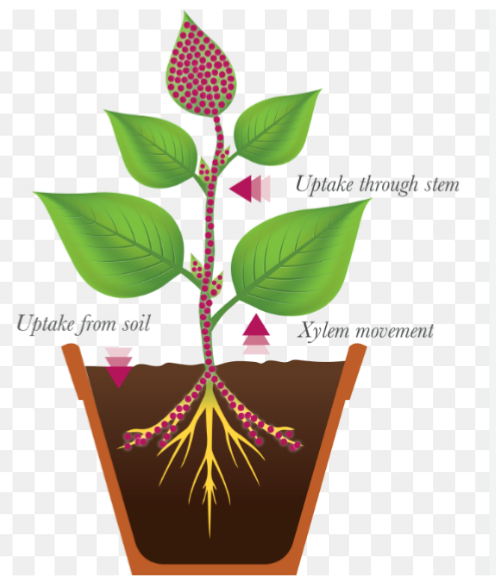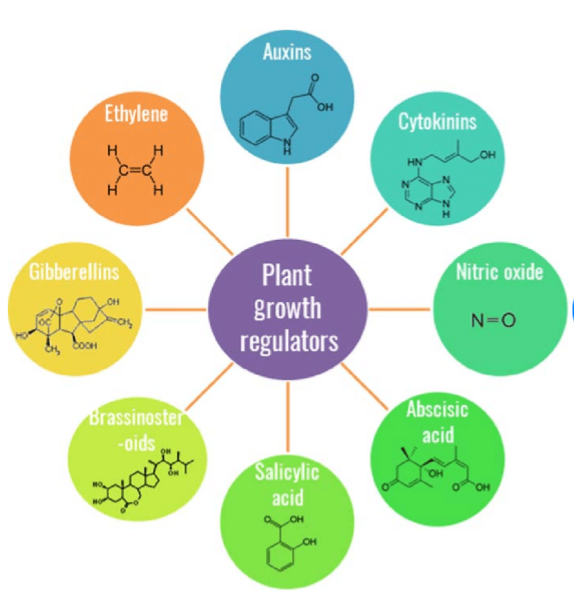
Plant growth and development not only depend on nutrients, light and water from the atmosphere and the soil as source of food but also depend on naturally occurring organic compounds called plant hormones. These hormones assist in internal coordination or communication between one part of the plant with another.
Phytohormones influences numerous physiological processes that occur in plant growth and development, and also in the plant death.
Plant growth substances are also called plant growth hormones or phytohormones and plant growth regulators (PGRs). They are chemicals used to modify plant growth such as increasing branching, suppressing shoot growth, increasing return bloom, removing excess fruit, or altering fruit maturity. They also affect: flowering, aging, root growth, distortion and killing of organs, prevention or promotion of stem elongation, colour enhancement of fruit, prevention of leafing, leaf fall or both, and many other conditions.
Hormones are produced naturally by plants, while plant growth regulators are applied to plants by humans. Plants require these substances in very small amount to bring about or produce major growth and developmental changes.
TYPES OF PLANT GROWTH SUBSTANCES
Plant growth substances are organic compounds that signal, regulate and control the growth of plants. They are of two types. They include :
1. synthetic regulators: such as IBA and Cycocel
2. natural hormones : such as IAA.
Application of synthetic plant growth regulators and natural hormones are done in in-vivo or in-vitro or In situ. The terms “in vivo” and “in vitro” describe different types of scientific research. “In vivo” means research done on a living organism, while “in vitro” which is a Latin word for “in glass.” means research procedures, tests, and experiments that researchers perform outside of a living organism. It is carried out in a laboratory dish or petri dish or test tube. It is a study carried out in a controlled environment.
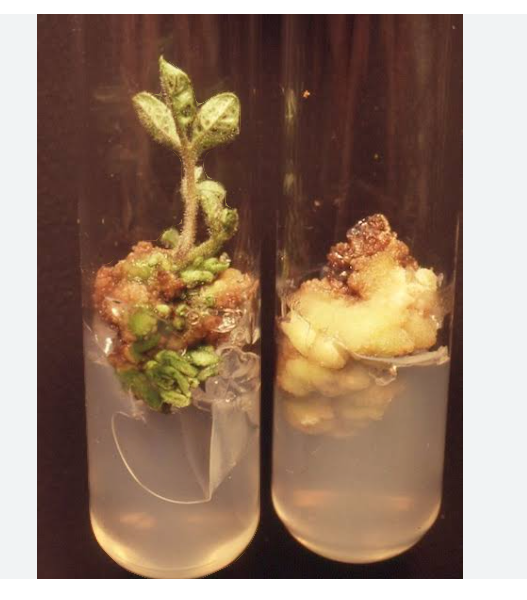
In situ means “in its original place.” It lies somewhere between in vivo and in vitro. Something that is performed in situ means that it’s observed in its natural context, but outside of a living organism.
1. SYNTHETIC GROWTH REGULATORS : These growth regulators usually mimic naturally occurring plant hormones. They perform the same functions with plant hormones : examples of the naturally occurring hormones with synthetic manufactured ones include:
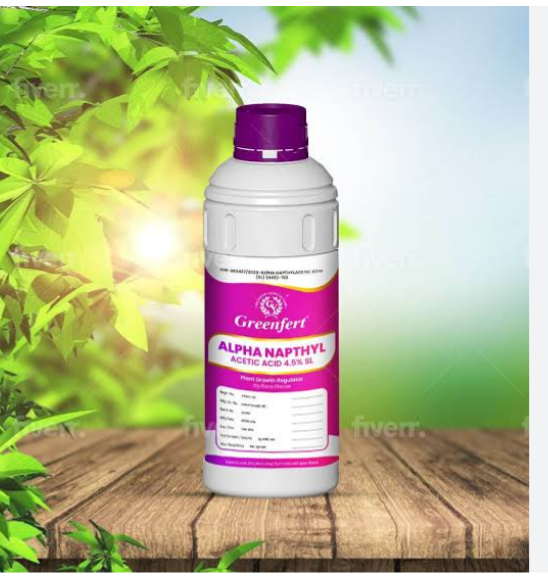
a. AUXIN: Commonly used synthetic auxins in tissue culture are 2,4-dichlorophenoxyacetic acid (2,4-D), 1-naphthaleneacetic acid (NAA), dicamba ((3,6-dichloro-2-methoxybenzoic acid) and picloram (4-amino-3,5,6-trichloropyridine-2-carboxylic acid).
b. CYTOKININ: Synthetic cytokinins are kinetin, benzylaminopurine (BA) and thidiazuron (TDZ).
c. GIBBERELLIN : Only gibberellic acid (GA3) and GA4+7 are often used in plant tissue culture.
d. ABSCISIC ACID (ABA) : Commercially sold ABA is a 1:1 mixture of the cis and trans-ABA optical isomers.
e. ETHYLENE : Ethephon (Ethrel; 2-chloroethylphosphonic acid; or 2-CEPA) can be used as an ethylene-releasing chemical in tissue cultures.
2. NATURAL HORMONES : These are chemicals extracted from plant tissue. They include:
a. AUXINS : Plants produce natural types of auxin like Indole butyric acid (IBA) and Indole-3-acetic acid (IAA).
b. CYTOKININS : The most commonly used natural cytokinins in plant tissue culture are zeatin, 2-iP 6-(γ,γ-Dimethylallylamino)purine and zeatin riboside.
c. GIBBERELLINS : There are over 80 different gibberellin compounds in plants. They are acidic and are named as follows – GA1, GA2, GA3….. GAn
d. ABSCISIC ACID : It is also called ABA. The most common natural form of ABA is (S)-(+)-abscisic acid. This compound is also called the cis isomer. The trans isomer has a slight difference in the chemical configuration compared to cis isomer. The positioning of their carboxyl group differs.
e. ETHYLENE .
These five hormones are involved in the coordination processes involved in plant growth. They act either singly or in association. They do exert powerful control over the plant function and development. In some cases, they exert their power over the rate of enzymatic activities within the plant system.
CLASSES OF PLANT GROWTH REGULATORS
Plant growth regulators can be grouped into five classes: auxins, gibberellins, cytokinins, abscisic acid and ethylene. These classes of plant growth regulators can further be divided into two subclasses based on their actions. They include
1. Plant growth promoters and
2. Plant growth inhibitors.
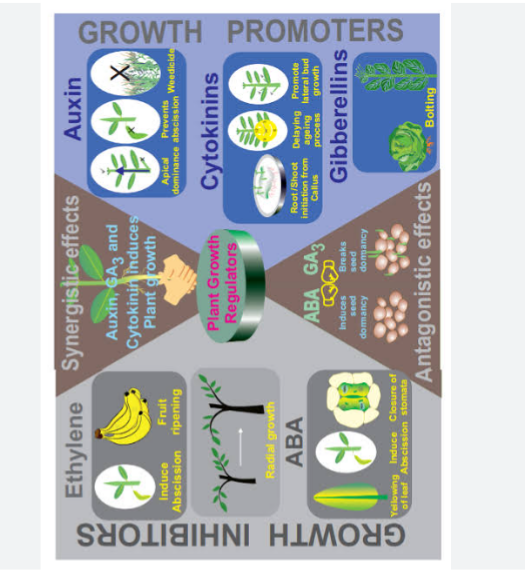
1. PLANT GROWTH PROMOTERS : These are plant growth regulators that function in promoting cell division, cell enlargement, flowering, fruiting and seed formation. They include: Auxins, Gibberellins, and Cytokinins
2. PLANT GROWTH INHIBITORS : These plant growth regulators function in inhibition of growth and promote dormancy and abscission in plants. They are used to keep the size and shape of the plants as well as control fruit production. They include: Abscisic acid and Ethylene.
Among the five plant growth regulators, only Ethylene serve a dual purpose function. It can be grouped either into the promoters or into the plant inhibitors.
THE PLANT GROWTH REGULATORS AND THEIR FUNCTIONS
1. AUXIN: It is a phytohormone discovered by Charles Darwin around the year 1880.The term Auxin is a Greek word meaning to grow. It naturally occur as indole-3 acetic acid – IAA, indole butyric acid and other related compounds. The synthetic sources include naphthalene acetic acid and 2, 4-dichlorophenoxyacetic ACID etc.
They are generally produced at the tip (apex) of shoots and roots, from where they are transported to other parts of the plants.
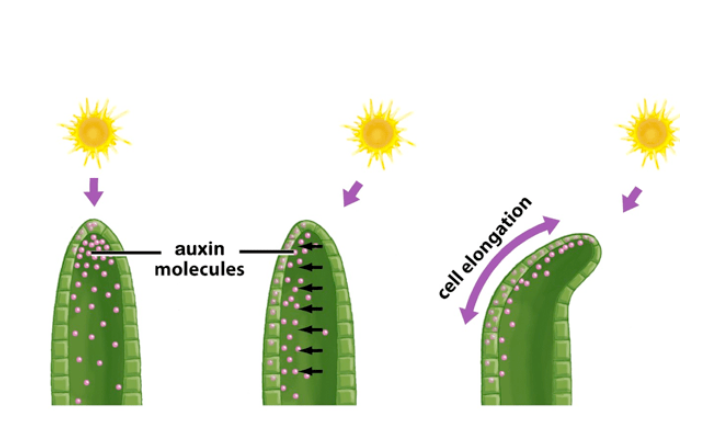
FUNCTIONS OF AUXINS
Generally, auxins at low concentration ;
a. Promote plant growth and facilitate flowering in plants
b. Promote cell enlargement and stem elongation
c. Used in the process of plant propagation.
d. Involved in the initiation of roots in stem cuttings and division of the cambia layer
e. Prevention of dropping of leaves and fruits at early stages.
f. Regulate xylem differentiation and assists in cell division.
g. It controls the development of branches in plant and are associated with apical domancy.
h. Auxins are widely used as herbicides to kill dicot weeds. For example 2,4 dichlorophenoxy acetic and 2,4,5 tri-chlorophenoxy acetic acid have herbicidal properties.
i. Used to produce fruit without preceding fertilization.
j. Promote natural detachment (abscission) of older leaves and fruits.
Translocation of auxine is usually in a particular direction. The direction is usually from the stem or shoot tip towards the root. This type of translocation is referred to as basi-petal.
2. GIBBERELLINS : Gibberellic acid was the first gibberellin to be discovered. It was discovered as a product of a fungus reffered to as Gibberellic fujikora which parasitize rice, making the rice plant to grow extremely tall. Today, there are more than 100 types of gibberellins gathered from a variety of organisms ranging from fungi to higher plants.They are acidic and are named as follows – GA1, GA2, GA3……… GAn etc.
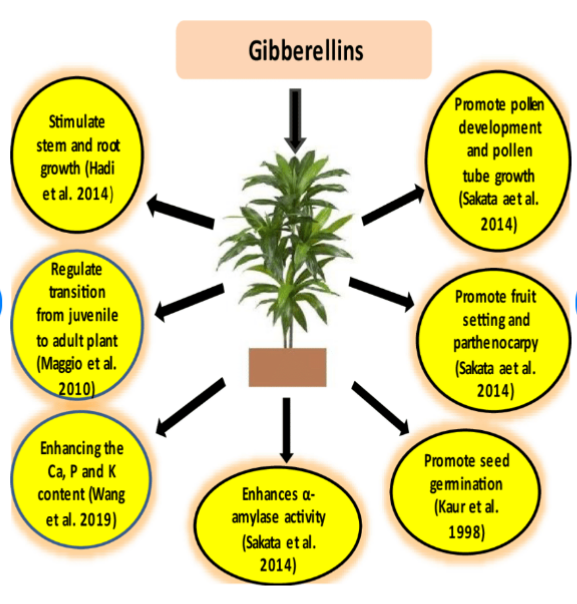
FUNCTIONS OF GIBBERELLINS
a. It eliminate dwarfism or shortness in plants. b. Delay senescence in fruits.
c. It reverses stunting caused by virus
d. Involved in leaf expansion and accelerate flowering
e. Break bud and seed dormancy.
f. It is used to induce or eliminate the need for cold treatment or photo periodic induction in plants like horticultural crops.
g. Promote bolting in cabbages and beet.
h. Facilitate elongation of fruits such as apples and enhance their shape.
I. It is used to break the period of rest and effect uniform germination of seeds of some plant species, especially in cereals.
j. Used by the brewing industry to accelerate malting process. K. Used as the spraying agent to increase the yield of sugarcane by elongation of the stem.
l. In young conifers, it is used to fasten the maturity period and facilitate early seed production
m. Helps in increasing the crop yield by increasing the height in plants such as sugarcane and increase the axis length in plants such as grape stalks.
Excessive application can cause gigantism.
3. CYTOKININS : This is a generic name for all naturally occurring substances known to promote cell division. They are also known as delay senescense. They are produced in the regions where cell division occurs, mostly in the roots and shoots.
The first naturally occurring cytokinin was discovered in corn and it is referred to as zeatin. They help in overcoming apical dominance and delay ageing of leaves.
The synthetic cytokinin include: benzladenine and 6 sulfuryl aminopourine or kinetic.
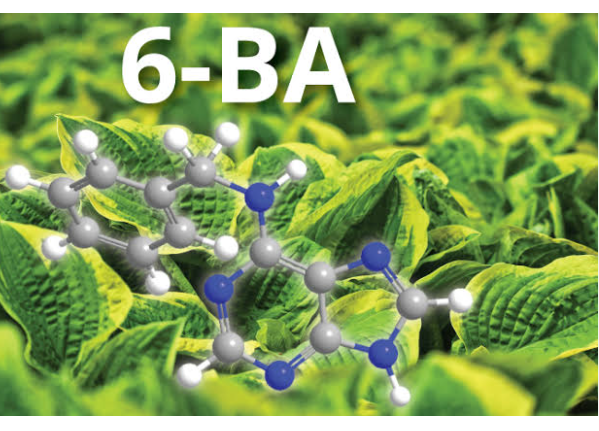
FUNCTIONS OF CYTOKININS
a. Promote or regulate or induce the production of DNA or RNA protein synthesis.
b. Break bud and seed dormancy.
c. Stimulate plant organ FORMATION. For example, leaf, fruits and buds etc
d. Promotes the growth of the lateral bud.
e. Promotes cell division and counteract or overcome apical dominance or break domancy.
f. They are used to keep flowers fresh for a longer time.
g. Used in tissue culture to induce cell division in mature tissues.
h. Enhance seed germination and uniform flowering
i. Facilitate adventitious shoot formation and lateral shoot growth.
j. Promotes nutrient mobilization that in turn assists delaying leaf senescence.
K. Used in the preservation of fruits, flowers and leafy vegetables
l. Helps in delaying the process of ageing (senescence) in fresh leaf crops like cabbage and lettuce.
m. Involved in the formation of new leaves and chloroplast organelles within the plant cell.
n. Used to induce the development of shoot and roots along with auxin, depending on the ratio.
4. ABSCISIC ACID : It was discovered in the 60s as a growth inhibitor. Then, it was called dormin but later, another compound abscisin-II was discovered and was called abscisic acid. It was called this name because of its regulatory effect on domancy and abscission.
This growth inhibitor is synthesized within the stem, leaves, fruits, and seeds of the plant. Mostly, abscisic acid antagonise the function of Gibberellic acid.
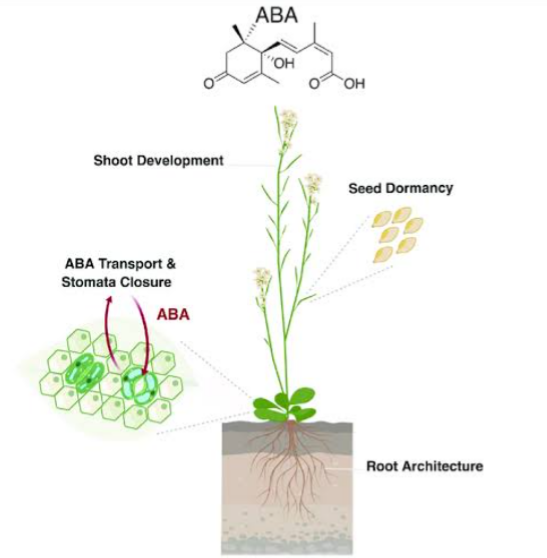
It is also known as the stress hormone as it helps by increasing the plant-tolerance to various types of stress.
FUNCTIONS OF ABSCISIC ACID
a. Stimulates closing of stomata in the epidermis. This helps to regulate response of leaves to water stress
b. Used to effect defoliation and the effect prevent sprouting in root crops
c. Helps in the maturation and development of seeds.
d. Inhibits plant metabolism and seed germination.
e. They are involve in formation of abscission. That is, the point at which fruits and leaves fall from the plant and dormancy.
f. It is widely used as a spraying agent on trees to regulate dropping of fruits.
G. Induces seed-dormancy and aids in withstanding desiccation and various undesired growth factors.
5. ETHYLENE : Ethylene is a simple, gaseous plant growth regulator, synthesised in small quantity by most of the plant organs including ripening fruits and ageing tissues. It is an unsaturated hydrocarbon having double covalent bonds between and adjacent to carbon atoms. It is difficult to obtain from plants.
Ethylene is used as both plant growth promoters and plant growth inhibitors. Ethylene is synthesized by the ripening fruits and ageing tissues. Thus, it is a ripening agent. Ethylene production is increased when plants are stress, and high concentrations of it is found within cells at the end of a plant’s life. An example is 2 chloroethylene phosphoric acid ( CEPA )
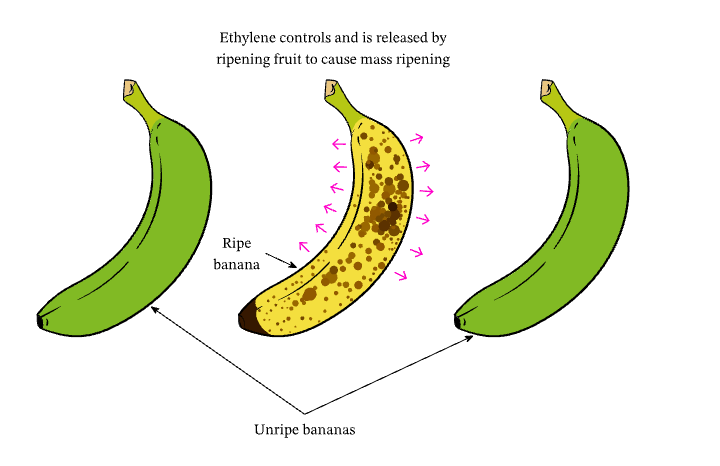
FUNCTIONS OF ETHYLENE
Ethylene is the most widely used plant growth regulator as it helps in regulating many physiological processes.
a. Induce flowering in the mango tree.
b. Promotes sprouting of potato tubers.
c. Breaks the dormancy of seeds and buds.
d. Enhances respiration rate during ripening of fruits.
e. Applied to rubber trees to stimulate the flow of latex.
f. Facilitates senescence and abscission of both flowers and leaves.
g. Used to stimulate the ripening of fruits. For example, tomatoes, citrus fruits and, apples. h. Promoting female flowering in cucumbers. It also accelerates abscission in cherry, walnut and cotton.
i. Affects horizontal growth of seedlings and swelling of the axis in dicot seedlings.
j. Increases root hair formation and growth, thus aids plant to expand their surface area for absorption
K. It causes leaves to droop (epinasty) and drop (abscission),
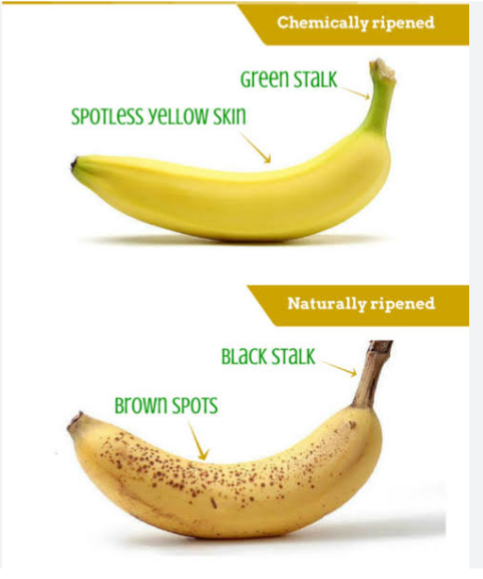
FACTORS AFFECTING PLANT GROWTH REGULATORS
Numerous factors affect PGR performance. These factors can be plant factors, environmental factors and physical and chemical factors. These factors include: how well the chemical is absorbed by the plant, tree vigour and age, dose, timing, cultivar, and weather conditions before, during, and after application. All of these factors should be put to consideration during a production system. Some of the factors are discussed below
1. PLANT SPECIES AND CULTIVARS
Plant species and cultivars differ in growth habits, response to chemical and stimuli. These plant species and cultivars respond differently to varying degrees of PGR application. Some cultivars respond to PGR at high rate while others respond at low rate . PGRs that work on one specie may not be effective on another specie. This makes these factor an important one that affect PGRs.
2. STAGE OF PLANT GROWTH
Plants undergo different cycle of growth stages. The growth stages start from when seeds are sown to stem development, internode elongation, leaf expansion, bud formation, flower opening, and physiological maturity. The rate at which plant respond to PGRs at the different stages of growth differs. It is important to note that varying weather condition like warmth, cold and light intensity do have effect on plant physiological development. Thus, affecting plant response to PGRs.
3. TEMPERATURE AND LIGHT
Plants grown under low temperature and light may require a lower dosage or fewer PGR applications than those grown under higher light and temperatures. Warm temperatures, slow drying conditions, are typically not preferred for application of PGRs. Applications during cool temperatures and fast drying conditions at evening or night-time are typically best to allow for proper drying time and to avoid volatilization and photo-degradation of PGRs.
4. WATER QUALITY AND AMOUNT
Water quality affects the activity of some PGRs like cytokinins and auxins. Water stressed plants respond to PGRs faster than unstressed plant. For example, ABA increased significantly under drought conditions compared with the control and waterlogged situation. Its concentrations increased consistently in drought conditions, especially in the plant roots. Also, pH has effect on PGRs. A combination of high pH (>7) and high alkalinity (>100 ppm calcium carbonate equivalent) may reduce the effectiveness of many PGRs.
5. APPLICATION RATES
Only little amount of PGRs is required for effective response by plant. Applications that are made early to a crop (proactive applications) generally need lower rates than those made to crops that are already vigorously growing (reactive applications). Application is best done in the evening than afternoon.
APPLICATION OF PLANT GROWTH REGULATORS
Plant growth substances are most often applied as a spray to foliage or as a liquid drench to the soil around plant base. Little concentration of the PGRs are needed to be applied to plants. Applied quantity ( concentrations) are usually measured in parts per million (ppm) and in some cases parts per billion (ppb). Generally, their effects are short-lived, and they may need to be reapplied in order to achieve the desired effect.
